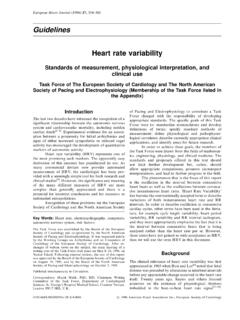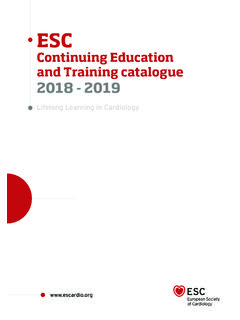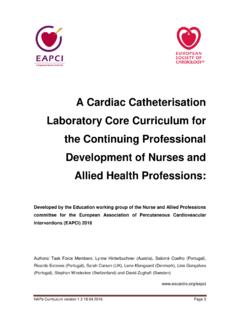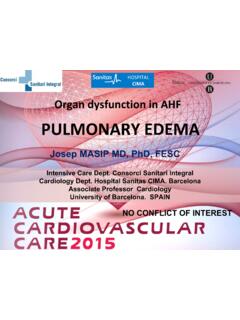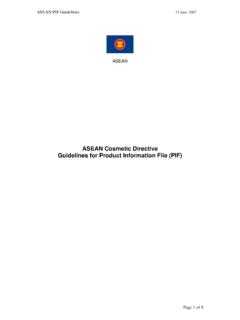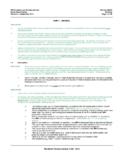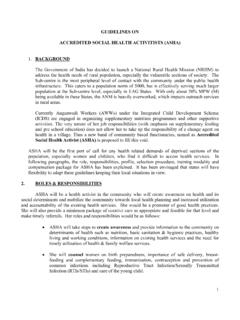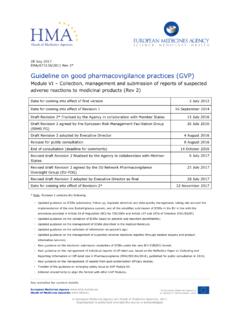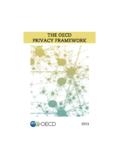Transcription of 2020ESC Guidelines for the diagnosisand management …
1 2020 ESC Guidelines for the diagnosis andmanagement of atrial fibrillation developed incollaboration with the European Association ofCardio-Thoracic Surgery (EACTS)The Task Force for the diagnosis and management of atrialfibrillation of the European Society of Cardiology (ESC)Developed with the special contribution of the European HeartRhythm Association (EHRA) of the ESCA uthors/Task Force Members: Gerhard Hindricks* (Chairperson) (Germany),Tatjana Potpara* (Chairperson) (Serbia), Nikolaos Dagres (Germany), Elena Arbelo(Spain), Jeroen J. Bax (Netherlands), Carina Blomstro m-Lundqvist (Sweden),Giuseppe Boriani (Italy), Manuel Castella1(Spain), Gheorghe-Andrei Dan(Romania), Polychronis E. Dilaveris (Greece), Laurent Fauchier (France),Gerasimos Filippatos (Greece), Jonathan M. Kalman (Australia), Mark La Meir1* Corresponding authors: The two chairpersons contributed equally to the Hindricks, University Clinic of Cardiology, Heart Center Leipzig, Department of Cardiology and Electrophysiology, Leipzig Heart Institute, Stru mpellstr.
2 39, 04289 Leipzig, Germany. Tel: 49 34 1865 1410, Fax: 49 34 1865 1460, Email: Potpara,School of Medicine, Belgrade University, dr Subotica 8, 11000 Belgrade, Serbia, and Cardiology Clinic, Clinical Centre of Serbia, Visegradska 26, 11000 Belgrade,Serbia. Tel: 38 11 1361 6319, Email: Committee for Practice Guidelines (CPG) and National Cardiac Societies document reviewers, and Author/Task Force Member affiliations: listed inthe the European Association of Cardio-Thoracic Surgery (EACTS)ESC entities having participated in the development of this document:Associations: Association for Acute CardioVascular Care (ACVC), Association of Cardiovascular Nursing & Allied Professions (ACNAP), European Association ofCardiovascular Imaging (EACVI), European Association of Preventive Cardiology (EAPC), European Association of Percutaneous Cardiovascular Interventions (EAPCI), EuropeanHeart Rhythm Association (EHRA), Heart Failure Association (HFA).
3 Councils: Council on Stroke, Council on Valvular Heart Groups: Cardiac Cellular Electrophysiology, Cardiovascular Pharmacotherapy, Cardiovascular Surgery, e-Cardiology, content of these European Society of Cardiology (ESC) Guidelines has been published for personal and educational use only. No commercial use is authorized. No part ofthe ESC Guidelines may be translated or reproduced in any form without written permission from the ESC. Permission can be obtained upon submission of awritten request toOxford University Press, the publisher of theEuropean Heart Journaland the party authorized to handle such permissions on behalf of the ESC ESC Guidelines represent the views of the ESC and were produced after careful consideration of the scientific and medical knowledge and the evidence avail-able at the time of their publication. The ESC is not responsible in the event of any contradiction, discrepancy and/or ambiguity between the ESC Guidelines and any other offi-cial recommendations or Guidelines issued by the relevant public health authorities, in particular in relation to good use of healthcare or therapeutic strategies.
4 Healthprofessionals are encouraged to take the ESC Guidelines fully into account when exercising their clinical judgment, as well as in the determination and the implementation of pre-ventive, diagnostic or therapeutic medical strategies; however, the ESC Guidelines do not override, in any way whatsoever, the individual responsibility of health professionals tomake appropriate and accurate decisions in consideration of each patient s health condition and in consultation with that patient and, where appropriate and/or necessary, thepatient s caregiver. Nor do the ESC Guidelines exempt health professionals from taking into full and careful consideration the relevant official updated recommendations orguidelines issued by the competent public health authorities, in order to manage each patient s case in light of the scientifically accepted data pursuant to their respective ethicaland professional obligations.
5 It is also the health professional s responsibility to verify the applicable rules and regulations relating to drugsand medical devices at the time European Society of Cardiology 2020. All rights reserved. For permissions please email: Heart Journal (2020)00,1 125 ESC (Belgium), Deirdre A. Lane (United Kingdom), Jean-Pierre Lebeau (France),Maddalena Lettino (Italy), Gregory Y. H. Lip (United Kingdom), Fausto J. Pinto(Portugal), G. Neil Thomas (United Kingdom), Marco Valgimigli (Switzerland),Isabelle C. Van Gelder (Netherlands), Bart P. Van Putte1(Netherlands),Caroline L. Watkins (United Kingdom)Document Reviewers: Paulus Kirchhof (CPG Review Coordinator) (United Kingdom/Germany), MichaelKu hne (CPG Review Coordinator) (Switzerland), Victor Aboyans (France), Anders Ahlsson1(Sweden),Pawel Balsam (Poland), Johann Bauersachs (Germany), Stefano Benussi1(Italy), Axel Brandes (Denmark),Frieder Braunschweig (Sweden), A.
6 John Camm (United Kingdom), Davide Capodanno (Italy), BarbaraCasadei (United Kingdom), David Conen (Canada), Harry J. G. M. Crijns (Netherlands), Victoria Delgado(Netherlands), Dobromir Dobrev (Germany), Heinz Drexel (Austria), Lars Eckardt (Germany), DonnaFitzsimons (United Kingdom), Thierry Folliguet (France), Chris P. Gale (United Kingdom), Bulent Gorenek(Turkey), Karl Georg Haeusler (Germany), Hein Heidbuchel (Belgium), Bernard Iung (France), Hugo (Germany), Dipak Kotecha (United Kingdom), Ulf Landmesser (Germany), Christophe Leclercq(France), Basil S. Lewis (Israel), Julia Mascherbauer (Austria), Jose Luis Merino (Spain), Be la Merkely(Hungary), Llu s Mont (Spain), Christian Mueller (Switzerland), Klaudia V. Nagy (Hungary), Jonas Oldgren(Sweden), Nikola Pavlovi c (Croatia), Roberto F. E. Pedretti (Italy), Steffen E. Petersen (United Kingdom),Jonathan P.
7 Piccini (United States of America), Bogdan A. Popescu (Romania), Helmut Pu rerfellner(Austria), Dimitrios J. Richter (Greece), Marco Roffi (Switzerland), Andrea Rubboli (Italy), Daniel Scherr(Austria), Renate B. Schnabel (Germany), Iain A. Simpson (United Kingdom), Evgeny Shlyakhto (Russia),Moritz F. Sinner (Germany), Jan Steffel (Switzerland), Miguel Sousa-Uva (Portugal), Piotr Suwalski1(Poland), Martin Svetlosak (Slovakia), Rhian M. Touyz (United Kingdom)The disclosure forms of all experts involved in the development of these Guidelines are available on theESC theSupplementary Datawhich include background information and detailed discussion of the datathat have provided the basis for the Guidelines atrial fibrillation anticoagulation vitamin K antagonists non-vitamin K antagonist oral antico-agulants left atrial appendage occlusion rate control rhythm control cardioversion antiarrhythmicdrugs catheter ablation pulmonary vein isolation left atrial ablation AF surgery upstream therapy ABC pathway screening stroke recommendationsTable of contents1 Preamble.
8 62 Introduction .. Diagnosis of atrial high-rate episodes/subclinical atrialfibrillation .. 144 Epidemiology .. Prediction of incident atrial fibrillation .. 166 Atrialfibrillationsubtypes,burden, .. Definition and assessment of atrial fibrillation burden .. Atrial cardiomyopathy: definition, classification, clinicalimplications, .. Benefits from and risks of screening for atrial fibrillation .. Cost-effectiveness of screening for atrial fibrillation .. 238 Diagnostic assessment in atrial fibrillation .. 239 Integrated management of patients with atrial fibrillation .. 262 ESC Definitions and components of integrated .. Role of healthcare systems and budget constraints .. Patient involvement and shared decision making .. Technology tools supporting atrial fibrillation management .. Advantages of integrated management of Measures (or approaches) for implementation ofintegratedmanagement.
9 2810 Patient management : the integrated ABC pathway .. A Anticoagulation/Avoidstroke .. Absolute contraindications to oral anticoagulants .. Non-vitamin K antagonist oral anticoagulants .. Combination therapy with oral anticoagulant andantiplateletdrugs .. Left atrial appendage occlusion and exclusion .. Left atrial appendage occlusion devices .. Surgical left atrial appendageocclusionorexclusion .. Long-term oral anticoagulation per atrialfibrillationburden .. Long-term oral anticoagulation per symptomcontrolstrategy .. management of anticoagulation-related bleeding risk .. Strategies to minimize the risk of bleeding .. B .. Target/optimal ventricular rate range .. Atrioventricular node ablation and pacing .. Indications for rhythm control .. Immediate cardioversion/elective cardioversion .. Pharmacological cardioversion(including pillinthepocket ).
10 Follow-up after cardioversion .. Atrial fibrillation catheter ablation .. Techniques and technologies .. AF catheter ablation outcome and impact Follow-up after atrial fibrillation ablation .. Risk assessment for recurrence of AF .. Concomitant surgery for atrial fibrillation:indications,outcome,complic ations .. Stand-alone surgery for atrial fibrillation:indications,outcome,complic ations .. Hybrid surgical/catheter ablation procedures .. Peri-procedural stroke risk management inpatients undergoing rhythm control interventions .. management of stroke risk and oral anticoagulanttherapy in atrial fibrillation patients management of stroke risk and oralanticoagulant therapy in atrial fibrillation patientsundergoing atrial fibrillation catheter ablation .. Postoperative anticoagulation after surgeryforatrialfibrillation.


